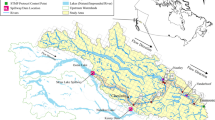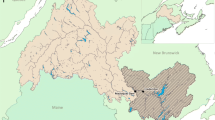Abstract
Water temperature is almost certainly a limiting factor in the maintenance of a self-sustaining rainbow trout (Oncorhynchus mykiss, formerlySalmo gairdneri) and brown trout (Salmo trutta) fishery in the lower reaches of the Cache la Poudre River near Fort Collins, Colorado, USA. Irrigation diversions dewater portions of the river, but cold reservoir releases moderate water temperatures during some periods. The US Fish and Wildlife Service’s Stream Network Temperature Model (SNTEMP) was applied to a 31-km segment of the river using readily available stream geometry and hydrological and meteorological data. The calibrated model produced satisfactory water temperature predictions (R 2=0.88,P<0.001, N=49) for a 62-day summer period. It was used to evaluate a variety of flow and nonflow alternatives to keep water temperatures below 23.3°C for the trout. Supplemental flows or reduced diversions of 3 m3/sec would be needed to maintain suitable summer temperatures throughout most of the study area. Such flows would be especially beneficial during weekends when current irrigation patterns reduce flows. The model indicated that increasing the riparian shade would result in little improvement in water temperatures but that decreasing the stream width would result in significant temperature reductions. Introduction of a more thermally tolerant redband trout (Oncorhynchus sp.), or smallmouth bass (Micropterus dolomieui) might prove beneficial to the fishery. Construction of deep pools for thermal refugia might also be helpful.
Similar content being viewed by others
Literature Cited
Anderson, J. W., and L. Miyajima. 1975. Analysis of the Vincent Creek fish rearing pool project. US Department of the Interior Bureau of Land Management Technical Note 274. Denver, Colorado, 25 pp.
Bartholow, J. M. 1989. Stream temperature investigations: Field and analytic methods. Instream Flow Information Paper No. 13. US Fish Wildlife Service Biological Report 89(17), 139 pp.
Barton, D. R., W. D. Taylor, and R. M. Biette. 1985. Dimensions of riparian buffer strips required to maintain trout habitat in southern Ontario streams.North American Journal of Fisheries Management 5:364–378.
Barton, J. R., and P. V. Winger. 1973. Rehabilitation of a channelized river in Utah. Pages 1–10in Proceedings of the 21st annual hydraulics division specialty conference, Montana State University, Bozeman. American Society of Civil Engineers, New York.
Bovee, K. D. 1982. A guide to stream habitat analysis using the Instream Flow Incremental Methodology. Instream Flow Information Paper 12. US Fish and Wildlife Service FWS/OBS-82/26, 248 pp.
Brungs, W. A., and B. R. Jones. 1977. Temperature criteria for freshwater fish: Protocol and procedures. US Environmental Protection Agency, Environmental Research Laboratory, Duluth, Minnesota. Report EPA-600/ 3-77-061, 129 pp.
Burnett, F. J. 1965. Golden memories of Colorado. Vantage Press, New York, 205 pp.
Carl, L. M., J. R. Ryckman, and W. C. Latta. 1976. Management of trout fishing in a metropolitan area. Fisheries Research Report No. 1836. Michigan Department of Natural Resources, Fishery Division, 29 pp.
Carpenter, L. G. 1916. Seepage and return waters, Part 1—General discussion and principles. Bulletin 180-Part 1. Colorado Agricultural College, Agricultural Experiment Station, Fort Collins, Colorado, 70 pp.
Cherry, D. S., K. L. Dickson, and J. Cairns, Jr. 1977. Preferred, avoided, and lethal temperatures of fish during rising temperature conditions.Journal of the Fisheries Research Board of Canada 34:239–246.
Clapp, D. F., R. D. Clark, and J. S. Diana. 1990. Range, activity, and habitat of large, free-ranging brown trout in a Michigan stream.Transactions of the American Fisheries Society 119:1022–1034.
Coutant, C. C. 1972. Biological aspects of thermal pollution II. Scientific basis for water temperature standards at power plants.CRC Critical Reviews in Environmental Control 3(1):1–24.
Edwards, E. A., G. Gebhart, and O. E. Maughan. 1983. Habitat suitability information: Smallmouth bass. US Department of the Interior, US Fish and Wildlife Service FWS/OBS-82/10.36, 47 pp.
Geffs, M. L. 1938. Under ten flags: A history of Weld County, Colorado. McVey Printery, Greeley, Colorado, 318 pp.
Hammer, T. R. 1972. Stream channel enlargement due to urbanization.Water Resources Research 8(6):1530–1540.
Hokanson, K. E. F., and K. E. Biesinger. No date. A national compendium of freshwater fish and water temperature data, Vol. II, field validation of freshwater fish temperature requirements (research report). US Environmental Protection Agency, Environmental Research Laboratory, Duluth, Minnesota, 116 pp.
Hokanson, K. E. F., C. F. Kleiner, and T. W. Thorslund. 1977. Effects of constant temperatures and diel temperature fluctuations on specific growth and mortality rates and yield of juvenile rainbow trout,Salmo gairdneri. Journal of the Fisheries Research Board of Canada 34:639–648.
Javaid, M. Y., and J. M. Anderson. 1967. Thermal acclimation and temperature selection in Atlantic salmon,Salmo salar, and rainbow trout,S. gairdneri.Journal of the Fisheries Research Board of Canada 24(7):1507–1513.
Kaya, C. M., L. R. Kaeding, and D. E. Burkhalter. 1971. Use of a cold-water refuge by rainbow and brown trout in a geothermally heated stream.Progressive Fish Culturist 39(1):37–39.
Klein, R. D. 1975. Urbanization and stream quality impairment.Water Resources Bulletin 15(4):948–963.
Leaf, C. F. no date. National Recreation Area study: Cache la Poudre River, draft report. Shakey Walker Assoc., Denver, Colorado, v.p.
Matlock, W. G. 1965. The effect of silt-laden water on infiltration in alluvial channels. PhD dissertation. University of Arizona, Tucson, Arizona, 102 pp.
Milhous, R. T., M. A. Updike, and D. M. Schneider. 1989. Physical habitat simulation system reference manual—version II. Instream Flow Information Paper No. 26. US Fish Wildlife Service Biological Report 89(16). v.p.
Nelson, P. C. 1987. Physical microhabitat versus streamflow relationships in the Cache la Poudre River, Fort Collins, Colorado. Poudre River Corridor Fishery Plan, Phase I Final Report. 8 pp. plus figures.
NOAA. 1987. Local climatological data annual summary with comparative values, Denver, Colorado.
Palos, G. 1975. Brief hydrologic history of the Cache la Poudre Basin between 1860 and 1970. M. W. Bittinger & Assoc. Inc., Fort Collins, Colorado, Ref: 433. 11 pp.
Perry, E. 1988. CLIMATEDATA user’s manual, TD 3200, summary of the day-cooperative observer network. US West Optical Publishing, Denver, Colorado, v.p.
Pitts, T. 1988. Plan of action for Poudre River Corridor Fishery Plan. Tom Pitts and Assoc., consulting engineers. 47 pp.
Raleigh, R. F., T. Hickman, R. C. Solomon, and P. C. Nelson. 1984. Habitat suitability information: Rainbow trout. US Fish and Wildlife Service FWS/OBS-82/10.60, 64 pp.
Raleigh, R. F., L. D. Zuckerman, and P. C. Nelson. 1986. Habitat suitability index models and instream flow suitability curves: Brown trout. US Fish and Wildlife Service Biological Report 82(10.124), revised, 65 pp.
Sonski, A. J. 1982. Heat tolerance of redband trout. Annual proceedings of the Texas chapter of the American Fisheries Society, 15–16 October 1982. Kerrville, Texas, 5:66–76.
Sonski, A. J. 1984. Comparison of heat tolerances of redband, Firehole River rainbow trout, and Wytheville rainbow trout. Annual proceedings of the Texas chapter of the American Fisheries Society, 6:27–35.
Theurer, F. D., and K. A. Voos. 1982. IFG’s Instream water temperature model validation. Pages 315–318in Conference on water and energy: technical and policy issues. American Society of Civil Engineers proceedings of the hydraulics conference, Pittsburgh, Pennsylvania, and Fort Collins, Colorado, 23–26 May and 23–27 June 1982.
Theurer, F. D., K. A. Voos, and W. J. Miller. 1984. Instream water temperature model. Instream Flow Information Paper 16. US Fish and Wildlife Service FWS/OBS-84/15, v.p.
Watrous, A. 1976. History of Larimer County, Colorado, 1911. Miller Manor Publications, Fort Collins, Colorado. Reprint of the 1911 edition, 513 pp.
Windell, J. T. 1978. Remaking a city trout stream.Trout 19(4):22–25.
Author information
Authors and Affiliations
Rights and permissions
About this article
Cite this article
Bartholow, J.M. A modeling assessment of the thermal regime for an urban sport fishery. Environmental Management 15, 833–845 (1991). https://doi.org/10.1007/BF02394821
Issue Date:
DOI: https://doi.org/10.1007/BF02394821




